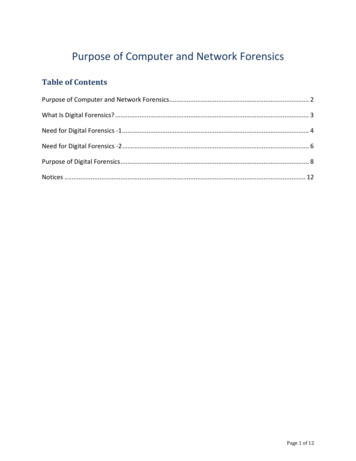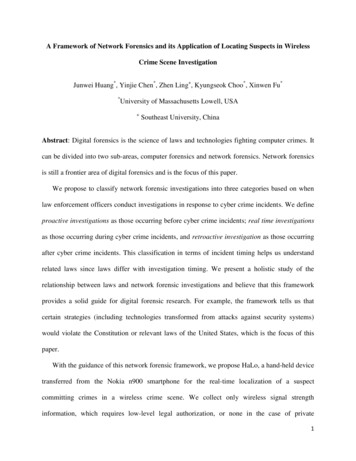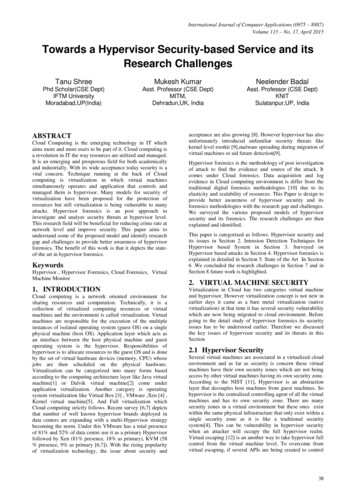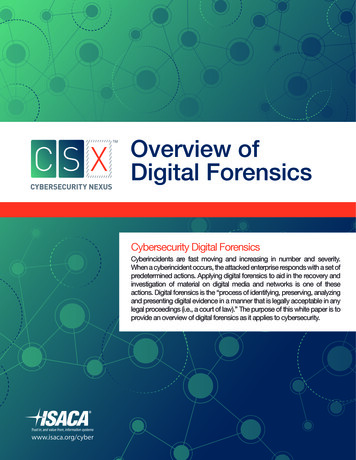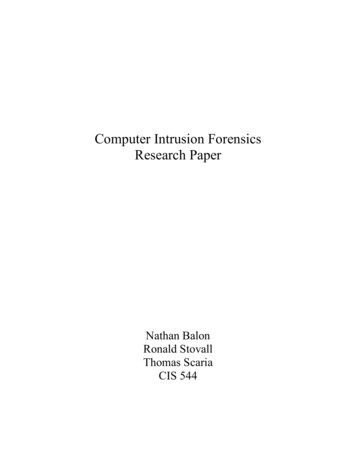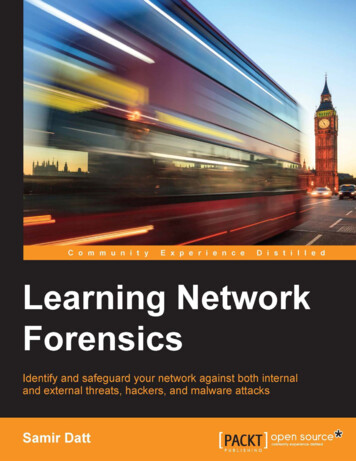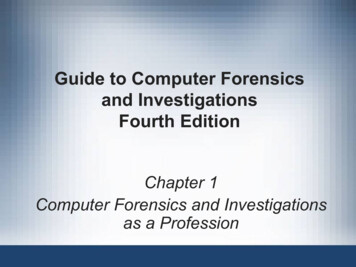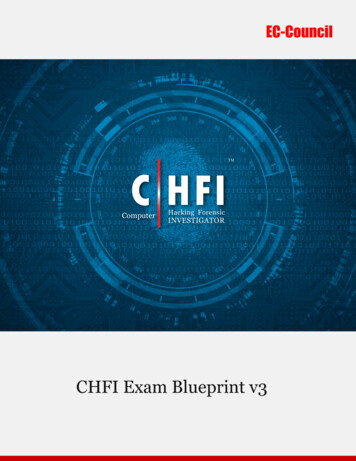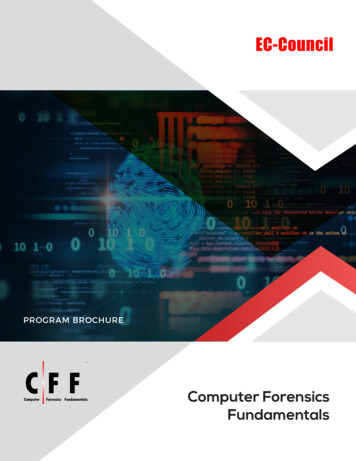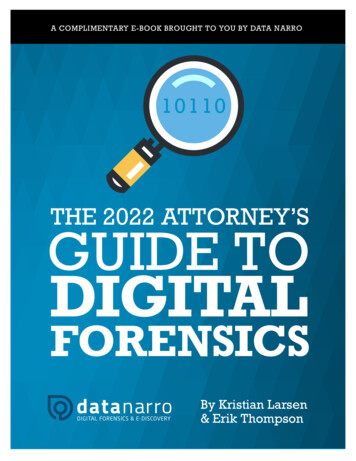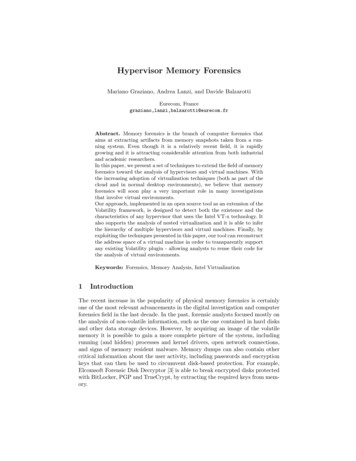
Transcription
Hypervisor Memory ForensicsMariano Graziano, Andrea Lanzi, and Davide BalzarottiEurecom, . Memory forensics is the branch of computer forensics thataims at extracting artifacts from memory snapshots taken from a running system. Even though it is a relatively recent field, it is rapidlygrowing and it is attracting considerable attention from both industrialand academic researchers.In this paper, we present a set of techniques to extend the field of memoryforensics toward the analysis of hypervisors and virtual machines. Withthe increasing adoption of virtualization techniques (both as part of thecloud and in normal desktop environments), we believe that memoryforensics will soon play a very important role in many investigationsthat involve virtual environments.Our approach, implemented in an open source tool as an extension of theVolatility framework, is designed to detect both the existence and thecharacteristics of any hypervisor that uses the Intel VT-x technology. Italso supports the analysis of nested virtualization and it is able to inferthe hierarchy of multiple hypervisors and virtual machines. Finally, byexploiting the techniques presented in this paper, our tool can reconstructthe address space of a virtual machine in order to transparently supportany existing Volatility plugin - allowing analysts to reuse their code forthe analysis of virtual environments.Keywords: Forensics, Memory Analysis, Intel Virtualization1IntroductionThe recent increase in the popularity of physical memory forensics is certainlyone of the most relevant advancements in the digital investigation and computerforensics field in the last decade. In the past, forensic analysts focused mostly onthe analysis of non-volatile information, such as the one contained in hard disksand other data storage devices. However, by acquiring an image of the volatilememory it is possible to gain a more complete picture of the system, includingrunning (and hidden) processes and kernel drivers, open network connections,and signs of memory resident malware. Memory dumps can also contain othercritical information about the user activity, including passwords and encryptionkeys that can then be used to circumvent disk-based protection. For example,Elcomsoft Forensic Disk Decryptor [3] is able to break encrypted disks protectedwith BitLocker, PGP and TrueCrypt, by extracting the required keys from memory.
Unfortunately, the increasing use of virtualization poses an obstacle to theadoption of the current memory forensic techniques. The problem is twofold.First, in presence of an hypervisor it is harder to take a complete dump of thephysical memory. In fact, most of the existing tools are software-based solutionsthat rely on the operating system to acquire the memory. Unfortunately, suchtechniques can only observe what the OS can see, and, therefore, might be unableto access the memory reserved by the virtual machine monitor itself [31]. Second,even when a complete physical image is acquired by using an hardware-basedsolution (e.g., through a DMA-enable device [2]), existing tools are not able toproperly analyze the memory image. While solutions exist for the first problem,such as a recently proposed technique based on the SMM [25], the second one isstill unsolved.Virtualization is one of the main pillars of cloud computing but its adoptionis also rapidly increasing outside the cloud. Many users use virtual machinesas a simple way to make two different operating systems coexist on the samemachine (e.g., to run Windows inside a Linux environment), or to isolate criticalprocesses from the rest of the system (e.g., to run a web browser reserved forhome banking and financial transactions). These scenarios pose serious problemfor forensic investigations. Moreover, any incident in which the attacker try toescape from a VM or to compromise the hypervisor in a cloud infrastructureremain outside the scope of current memory forensic techniques.In this paper we propose a new solution to detect the presence and the characteristics of an hypervisor and to allow existing memory forensic techniquesto analyze the address space of each virtual machine running inside the system. Nowadays, if an investigator takes a complete physical snapshot of Alicecomputer’s memory while she is browsing the Internet from inside a VMwaremachine, none of the state of the art memory analysis tools can completelyanalyze the dump. In this scenario, Volatility [6], a very popular open sourcememory forensic framework, would be able to properly analyze the host operating system and observe that the VMware process was running on the machine.However, even though the memory of the virtual machine is available in thedump, Volatility is currently not able to analyze it. In fact, only by properlyanalyzing the hypervisor it is possible to gain the information required to translate the guest virtual addresses into physical addresses, the first step requiredby most of the subsequent analysis. Even worse, if Alice computer was infectedby some advanced hypervisor-based rootkit, Volatility would not even be ableto spot its presence.In some way, the problem of finding an hypervisor is similar to the one ofbeing able to automatically reconstruct information about an operating systemin memory, even though that operating system may be completely unknown. Thenumber of commodity hypervisors is limited and, given enough time, it wouldbe possible to analyze all of them and reverse engineer their most relevant datastructures, following the same approach used to perform memory forensics ofknown operating systems. However, custom hypervisors are easy to develop andthey are already adopted by many security-related tools [15,22,28,29]. Moreover,
malicious hypervisors (so far only proposed as research prototypes [12,19,26,33])could soon become a reality - thus increasing the urgency of developing the areaof virtualization memory forensics.The main idea behind our approach is that, even though the code and internals of the hypervisors may be unknown, there is still one important piece ofinformation that we can use to pinpoint the presence of an hypervisor. In fact,in order to exploit the virtualization support provided by most of the modernhardware architectures, the processor requires the use of particular data structures to store the information about the execution of each virtual environment.By first finding these data structures and then analyzing their content, we canreconstruct a precise representation of what was running in the system undertest.Starting from this observation, this paper has three main goals. First, wewant to extend traditional memory forensic techniques to list the hypervisorspresent in a physical memory image. As it is the case for traditional operatingsystems, we also want to extract as much information as possible regarding thosehypervisors, such as their type, location, and the conditions that trigger theirbehaviors. Second, we want to use the extracted information to reconstruct theaddress space of each virtual machine. The objective is to be able to transparentlysupport existing memory analysis techniques. For example, if a Windows user isrunning a second Windows OS inside a virtual machine, thanks to our techniquesa memory forensic tool to list the running processes should be able to apply itsanalysis to either one or the other operating system. Finally, we want to be ableto detect cases of nested virtualization, and to properly reconstruct the hierarchyof the hypervisors running in the system.To summarize, in this paper we make the following contributions:– We are the first to design a forensics framework to analyze hypervisor structures in physical memory dumps.– We implemented our framework in a tool named Actaeon, consisting of aVolatility plugin, a patch to the Volatility core, and a standalone tool todump the layout of the Virtual Machine Control Structure (VMCS) in different environments.– We evaluate our framework on several open source and commercial hypervisors installed in different nested configurations. The results show that oursystem is able to properly recognize the hypervisors in all the configurationwe tested.2BackgroundBefore presenting our approach for hypervisor memory forensics we need tointroduce the Intel virtualization technology and present some background information on the main concepts we will use in the rest of the paper.
2.1Intel VT-x TechnologyIn 2005, Intel introduced the VT-x Virtualization Technology [18], a set ofprocessor-level features to support virtualization on the x86 architecture. Themain goal of VT-x was to reduce the virtualization overhead by moving theimplementation of different tasks from software to hardware.VT-x introduces a new instruction set, called Virtual Machine eXtension(VMX) and it distinguishes two modes of operation: VMX root and VMX nonroot. The VMX root operation is intended to run the hypervisor and it is therefore located below “ring 0”. The non root operation is instead used to run theguest operating systems and it is therefore limited in the way it can access hardware resources. Transitions between non root and root modes are called VMEXIT,while the transition in the opposite direction are called VMENTRY. As part of theVT-x technology, Intel introduced a set of new instructions that are availablewhen the processor is operating in VMX root operation, and modified some ofthe existing instructions to trap (e.g., to cause a VMEXIT) when executed insidea guest OS.2.2VMCS LayoutVMX transitions are controlled by a data structure called Virtual Machine Control Structure (VMCS). This structure manages the transitions from and toVMX non root operation as well as the processor behavior in VMX non root operation. Each logical processor reserves a special region in memory to contain theVMCS, known as the VMCS region. The hypervisor can directly reference theVMCS through a 64 bit, 4k-aligned physical address stored inside the VMCSpointer. This pointer can be accessed using two special instructions (VMPTRSTand VMPTRLD) and the VMCS fields can be configured by the hypervisor throughthe VMREAD, VMWRITE and VMCLEAR commands.Theoretically, an hypervisor can maintain multiple VMCSs for each virtualmachine, but in practice the number of VMCSs normally matches the numberof virtual processors used by the guest VM. The first word of the VMCS regioncontains a revision identifier that is used to specify which format is used in therest of the data structure. The second word is the VMX ABORT INDICATOR, and itis always set to zero unless a VMX abort is generated during a VMEXIT operationand the logical processor is switched to shutdown state. The rest of the structurecontains the actual VMCS data. Unfortunately, the memory layout (order andoffset) of the VMCS fields is not documented and different processors store theinformation in a different way.Every field in the VMCS is associated with a 32 bit value, called its encoding,that needs to be provided to the VMREAD/VMWRITE instructions to specify howthe values has to be stored. For this reason, the hypervisor has to use these twoinstructions and should never access or modify the VMCS data using ordinarymemory operations.The VMCS data is organized into six logical groups: 1) a guest state area tostore the guest processor state when the hypervisor is executing; 2) a host state
/ ERVISORHYPERVISOR/ /HOSTHOST(L0)(L0)HARDWAREHARDWAREFig. 1. VMCS structures in a Turtle-based nested virtualization setuparea to store the processor state of the hypervisor when the guest is executing; 3)a VM Execution Control Fields containing information to control the processorbehavior in VMX non root operation; 4) VM Exit Control Fields that controlthe VMEXITs; 5) a VM Entry Control Fields to control the VMENTRIES; and6) a VM Exit Info Fields that describe the cause and the nature of a VMEXIT.Each group contains many different fields, but the offset and the alignmentof each field is not documented and it is not constant between different Intelprocessor families1 .2.3Nested VirtualizationNested virtualization has been first defined by Popek and Goldberg [16, 24] in1973. Since then, several implementation has been proposed. In a nested virtualization setting, a guest virtual machine can run another hypervisor thatin turn can run other virtual machines, thus achieving some form of recursivevirtualization. However, since the x86 architecture provides only a single-levelarchitectural support for virtualization, there can only be one and only one hypervisor mode and all the traps, at any given nested level, need to be handledby this hypervisor (the “top” one in the hierarchy). The main consequence isthat only a single hypervisor is running at ring -1 and has access to the VMXinstructions. For all the other nested hypervisors the VMX instructions haveto be emulated by the top hypervisor to provide to the nested hypervisors theillusion of running in root mode.Because of these limitations, the support for nested virtualization needs to beimplemented in the top hypervisor. KVM has been the first x86 virtual machinemonitor to fully support nested virtualization using the Turtle technology [9]. Forthis reason, in the rest of this paper we will use the KVM/Turtle nomenclaturewhen we refer to nested hypervisors. Recent versions of Xen also adopted thesame concepts and it is reasonable to think that also proprietary hypervisors(such as VMware and Hyper-V) use similar implementations.1For more information on each VMCS section please refer to the Intel Manual Vol3B Chapter 20
The Turtle architecture is depicted in Figure 1. In the example, the tophypervisor (L0) runs a guest operating system inside which a second hypervisor(L1) is installed. Finally, this second hypervisor runs a nested guest operatingsystem (L2). In this case the CPU uses a first VMCS (VMCS01) to controlthe top hypervisor and its guest. The nested hypervisor has a “fake” VMCS(VMCS12) to mange the interaction with its nested OS (L2). Since this VMCSis not real but it is emulated by the top hypervisor, its layout is not decided bythe processor, but can be freely chosen by the hypervisor developers. The twoVMCSs are obviously related to each other. For example, in our experiments,we observed that for KVM the VMCS12 Host State Area corresponds to theVMCS01 Guest State Area.The Turtle approach also adds one more VMCS (VMCS02), that is used bythe top hypervisor (L0) to manage the nested OS (L2). In theory, nested virtualization could be implemented without using this additional memory structure.However, all the hypervisors we analyzed in our tests adopted this approach.Another important aspect that complicates the nested virtualization setupis the memory virtualization. Without nested virtualization, the guest operatingsystem has its own page tables to translate the Guest Virtual Addresses (GVAs)to the Guest Physical Addresses (GPAs). The GPA are then translated by thehypervisor to Host Physical Addresses (HPAs) that are pointing to the actualphysical pages containing the data. This additional translation can be done eitherin software (e.g., using shadow page tables [30]) or in hardware (e.g., using theExtended Page Tables (EPT) described later in this section). The introductionof the nested virtualization adds one more layer of translation. In fact, the twodimensional support is no longer enough to handle the translation for nestedoperating systems. For this reason, Turtle introduced a new technique calledmultidimensional-paging in which the nested translations (from L2 to L1 inFigure 1) are multiplexed into the two available layers.2.4Extended Page TableSince the introduction of the Nehalem microarchitecture [5], Intel processorsadopted an hardware feature, called Extended Page Tables (EPT), to supportaddress translation between GPAs and HPAs. Since the use of this technologygreatly alleviated the overhead introduced by memory translation, it quicklyreplaced the old and slow approach based on shadow pages tables.When the EPT is enabled, it is marked with a dedicated flag in the SecondaryBased Execution Control Field in the VMCS structure. This tells the CPU thatthe EPT mechanism is active and it has to be used to translate the guest physicaladdresses.The translation happens through different stages involving four EPT paging structures (namely PML4, PDPT, PD, and PT). These structures are verysimilar to the ones used for the normal IA-32e address mode translation. If thepaging is enabled in the guest operating system the translation starts from theguest paging structures. The PML4 table can be reached by following the corresponding pointer in the VMCS. Then, the GPA is split and used as offset to
Fig. 2. EPT-based Address Translationchoose the proper entry at each stage of the walk. The EPT translation processis summarized in Figure 2.4. 23Objectives and MotivationsOur goal is to bring the memory forensic area to the virtualization world. Thisrequires the introduction of new techniques to detect, recognize, and analyze thefootprint of hypervisors inside the physical memory. It also requires to supportprevious techniques, so that existing tools to investigate operating systems anduser-space programs could be easily applied to each virtual machine inside amemory image.Locate Hypervisors in MemoryIf an hypervisor is known, locating it in memory could be as simple as lookingfor a certain pattern of bytes (e.g., by using a code-based signature). Unfortunately, this approach have some practical limitations. In fact, given a snapshotof the physical memory collected during an investigation, one of the main question we want to ask is “Is there any hypervisor running on the system?”. Eventhough a signature database could be a fast way to detect well-known products,custom hypervisors are nowadays developed and used in many environments.Moreover, thin hypervisor could also be used for malicious purposes, such asthe one described by Rutkowska [26], that is able to install itself in the systemand intercept critical operations. Detecting this kind of advanced threats is alsogoing to become a priority for computer forensics in the near future.For these reasons, we decided to design a generic hypervisor detector. Inorder to be generic, it needs to rely on some specific features that are required2For more detail about EPT look at Vol 3B, Chapter 25 Intel Manuals.
by all hypervisors to run. As explained in the previous section, to provide hardware virtualization support, the processor requires certain data structures to bemaintained by the hypervisor. For Intel, this structure is called VMCS, whilethe equivalent for AMD is called VMCB. If we can detect and analyze thosestructures we could use them as entry points to find all the other components:hypervisors, hosts, and guest virtual machines.To show the feasibility of our approach, we decided to focus our effort on theIntel architecture. There are two reasons behind this choice. First, Intel largelydominates the market share (83% vs 16% in the second quarter of 2012 [1]).Second, the AMD virtualization structures are fixed and well documented, whileIntel adopts a proprietary API to hide the implementation details. Even worse,those details vary between different processor families. Therefore, it provided amuch harder scenario to test our techniques.A limitation of our choice is that our approach can only be applied to hardware assisted hypervisors. Old solutions based on para-virtualization are notsupported, since in this case the virtualization is completely implemented insoftware. However, these solution are becoming less and less popular because oftheir limitations in terms of performance.Analysis of Nested VirtualizationFinding the top hypervisor, i.e. the one with full control over the machine, iscertainly the main objective of a forensic analysis. But since now most of thecommodity hypervisors support nested virtualization, extracting also the hierarchy of nested hypervisors and virtual machines could help an analyst to gaina better understanding of what is running inside the system.Unfortunately, developing a completely generic and automated algorithm toforensically analyze nested virtualization environments is - in the general case impossible. In fact, while the top hypervisor has to follow specific architecturalconstraints, the way it supports nested hypervisors is completely implementation specific. In a nested setup, the top hypervisor has to emulate the VMXinstructions, but there are no constraints regarding the location and the formatin which it has to store the fields of the nested VMCS. In the best-case scenario,the fields are recorded in a custom VMCS-like structure, that we can reverseengineer in an automated way by using the same technique we use to analyzethe layouts of the different Intel processor families. In the worse case, the fieldscould be stored in complex data structures (such as hash tables) or saved in anencoded form, thus greatly complicating the task of locating them in the memorydump.Not every hypervisor support nested virtualization (e.g. VirtualBox doesnot). KVM and Xen implement it using the Turtle [9] approach, and a similar technique to multiplex the inner hypervisors VT-x/EPT into the underlyingphysical CPU is also used by VMware [7].By looking for the nested VMCS structure (if known) or by recognizing theVMCS02 of a Turtle-like environment (as presented in Figure 1 and explained
in details in Section 4), we can provide an extensible support to reconstruct thehierarchy of nested virtualization.Virtual Machine Forensic IntrospectionOnce a forensic analyst is able to list the hypervisors and virtual machines in amemory dump, the next step is to allow her to run all her memory forensic toolson each virtual machine. For example, the Volatility memory forensic frameworkships with over 60 commands implementing different kinds of analysis - andmany more are available through third-party plugins. Unfortunately, in presenceof virtualization, all these commands can only be applied to the host virtualmachine. In fact, the address spaces of the other VMs require to be extractedand translated from guest to host physical addresses.The goal of our introspection analysis is to parse the hypervisor information, locate the tables used by the EPT, and use them to provide a transparentmechanism to translate the address space of each VM.4System DesignOur hypervisor analysis technique consists of three different phases: memoryscanning, data structure validation, and hierarchy analysis. The Memory Scannertakes as input a memory dump and the database of the known VMCS layouts(i.e., the offset of each field in the VMCS memory area) and outputs a numberof candidate VMCS. Since the checks performed by the scanner can producefalse positives, in the second phase each structure is validated by analyzingthe corresponding page table. The final phase of our approach is the hierarchyanalysis, in which the validated VMCSs are analyzed to find the relationshipsamong the different hypervisors running on the machine.In the following sections we will describe in details the algorithms that wedesigned to perform each phase of our analysis.4.1Memory ScannerThe goal of the memory scanner is to scan a physical memory image looking fordata structures that can represent a VMCS. In order to do that, we need twotypes of information: the memory layout of the structure, and a set of constraintson the values of its fields that we can use to identify possible candidates. TheVMCS contains over 140 different fields, most of which can assume arbitraryvalues or they can be easily obfuscated by a malicious hypervisors. The memoryscanner can tolerate false positives (that are later removed by the validationroutine) but we want to avoid any false negative that could result in a missedhypervisor. Therefore we designed our scanner to focus only on few selectedfields:
– Revision ID: It is the identifier that determines the layout of the rest ofthe structure. For the VMCS of the top hypervisor, this field has to matchthe value of the IA32 VMX BASIC MSR register of the machine on which theimage was acquired (and that changes between different micro-architecture).In case of nested virtualization, the revision ID of the VMCS12 is chosen bythe top hypervisor. The Revision ID is always the first word of the VMCSdata structure.– VMX ABORT INDICATOR: This is the VMX abort indicator and its value hasto be zero. The field is the second entry of the VMCS area.– VmcsLinkPointerCheck: The values of this field consists of two consecutive words that, according to the Intel manual, should always be set to0xffffffff. The position of this field is not fixed.– Host CR4: This field contains the host CR4 register. Its 13th bit indicates ifthe VMX is enabled or not. The position of this field is not fixed.To be sure that our choice is robust against evasions, we implemented a simplehypervisor in which we tried to obfuscate those fields during the guest operationand re-store them only when the hypervisor is running, a similar approach isdescribed in [14]. This would simulate what a malicious hypervisor could do inorder to hide the VMCS and avoid being detected by our forensic technique. Inour experiments, any change on the values of the previous five fields produced asystem crash, with the only exception of the Revision ID itself. For this reason,we keep the revision ID only as a key in the VMCS database, but we do notcheck its value in the scanning phase.The memory scanner first extracts the known VMCS layouts from the databaseand then it scans the memory looking for pages containing the aforementionedvalues at the offsets defined by the layout. Whenever a match is found, thecandidate VMCS is passed over to the validation step.4.2VMCS ValidationOur validation algorithm is based on a simple observation. Since the HOST CR3field needs to point to the page table that is used by the processor to translate thehypervisor addresses, that table should also contain the mapping from virtual tophysical address for the page containing the VMCS itself. We call this mechanismself-referential validation.For every candidate VMCS, we first extract the HOST CR3 field and we assumethat it points to a valid page table structure. Unfortunately, a page table canbe traversed only by starting from a virtual address to find the correspondingphysical one, but not vice-versa. In our case, since we only know the physicaladdress of the candidate VMCS, we need to perform the opposite operation. Forthis reason, our validator walks the entire page tables (i.e., it tries to follow everyentry listed in them) and creates a tree representation where the leaves representthe mapped physical memory pages and the different levels of the tree representthe intermediate points of the translation algorithm (i.e., the page directory, andthe page tables).
Fig. 3. Self-referential Validation TechniqueThis structure has a double purpose. First, it serves as a way to validate acandidate VMCS, by checking that one of the leaves points to the VMCS itself(see Figure 3). If this check fails, the VMCS is discarded as a false positive.Second, if the validation succeeded, the tree can be used to map all the memorypages that were reserved by the hypervisor. This could be useful in case ofmalicious hypervisors that need an in-depth analysis after being discovered.It is important to note that the accuracy of our validation technique leverageson the assumption that is extremely unlikely that such circular relationship canappear by chance in a memory image.4.3Reverse Engineering The VMCS LayoutThe previous analysis steps are based on the assumption that our database contains the required VMCS layout information. However, as we already mentionedin the previous sections, the Intel architecture does not specify a fix layout, butprovides instead an API to read and write each value, independently from itsposition.In our study we noticed that each processor micro-architecture defines different offsets for the VMCS fields. Since we need these offsets to perform ouranalysis, we design and implement a small hypervisor-based tool to extract themfrom a live system.More in detail, our algorithm considers the processors microcode as a blackbox and it works as follows. In the first step, we allocate a VMCS memory regionand we fill the corresponding page with a 16 bit-long incremental counter. Atthis point the VMCS region contains a sequence of progressive numbers rangingfrom 0 to 2048, each representing its own offset into the VMCS area. Then, weperform a sequence of VMREAD operations, one for each field in the VMCS. As aresult, the processor retrieves the field from the right offset inside the VMCS pageand returns its value (in our case the counter that specifies the field location).
Fig. 4. Comparison between different VMCS fields in nested and parallel configurationsThe same technique can also be used to dump the layout of nested VMCSs.However, since in this case our tool would run as a nested hypervisor, the tophypervisor could implement a protection mechanism to prevent write access tothe VMCS region (as done by VMware), thus preventing our technique to work.In this case we adopt the opposite, but much slower, approach of writing eachfield with a VMWRITE and then scan the memory for the written value.4.4Virtualization Hierarchy AnalysisIf our previous techniques detect and validate more then one VMCS, we need todistinguish between several possibilities, depending whether the VMCS represent parallel guests (i.e., a single hypervisor running multiple virtual machines),nested guests (i.e, an hypervisor running a machine the runs another hypervisor),or a combination of the previo
Hypervisor Memory Forensics Mariano Graziano, Andrea Lanzi, and Davide Balzarotti Eurecom, France graziano,lanzi,balzarotti@eurecom.fr Abstract. Memory forensics is the branch of computer forensics that aims at extracting artifacts from memory snapshots taken from a run-ning system. Even though it is a relatively recent eld, it is rapidly
